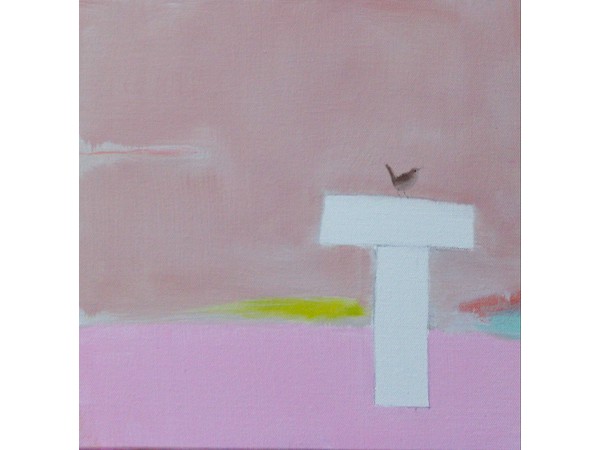Andrew Squire
'As an artist I've always been fascinated by birds and animals. As an environmental activist I'm very aware of the climatic and ecological catastrophe we're leaving in our wake.
These latest paintings are a simple expression of love and respect for the natural world, focusing on just a handful of the millions of species with whom we co-exist.'
Andrew Squire trained as an architect at Manchester University in the 1970s, where he was exposed simultaneously to the influences of classic Modernist design and the beginnings of the radical community architecture movement. This was to shape his development as an artist in the creative melting pot of 1980's Glasgow. His painting has evolved into a mature art which is rigorously structured in terms of colour and composition, whilst reflecting a wide range of concerns and interests, not least the many facets of sustainability and ecology. His close chromatic harmonies and expressive reduction to the essentials of each subject are underpinned by skilled draughtsmanship, and frequent visual wit.
1972-79 Manchester University School of Architecture
1983-84 Transmission Artists Collective, Glasgow
1982-84 ASSIST Architects Co-operative, Glasgow
1984-03 Key Housing Association, Glasgow
RESIDENCIES
1995 Akureyri Arts Centre, Iceland
2001 Pouch Cove Foundation, St John's, Newfoundland
2002 Siddhartha Art Gallery, Kathmandu
SOLO EXHIBITIONS
1993 Gallery Gram, Aalborg, Denmark (solo)
2000 Roger Billcliffe Gallery, Glasgow (solo)
2001 Thompson's Gallery, Marylebone, London (solo)
2003 Thompson's Gallery, Marylebone, London (solo)
2005 Skypark, Glasgow (solo)
2007 Thompson's Gallery, Marylebone, London (solo)
2009 Thompson's Gallery, Marylebone, London (solo)
2011 Thompson's Gallery, Marlebone, London (solo)
2012 World Land Trust Gallery in association with Stafford Gallery
2013 Thompson's Gallery, Marlebone, London (solo)
2014 Stafford Gallery, Wimbledon Village, SW19 5DQ
SELECTED EXHIBITIONS
1986 Contemporary Art from Glasgow: Nürnberg, Germany
1987-91 Radical Scotland, Leeds Postcards, New Statesman: cartoons
1987 Open Circle, Glasgow: German touring exhibition
1990 Glasgow DC: Drawings on Buses
1992-99 RSA, RSW, RGI annual exhibitions
1995 Hunter & Squire, Artbank, Glasgow
1996-98 Grave Goods: Crawford Arts Centre touring exhibition
1997 Scotland on Sunday/Noble Grossart prize exhibition
1997 The Glenlivet Competition - winner (commission)
2000-01 Scotland House Exhibition, Brussels
2002 Club Med Competition - winner (commission)
2003 Courant d'Art Gallery, Paris
2003 Green Gallery, Munich
2004 Thompson’s Gallery, London 2004
2004 Baillie Gallery, London
2004 Green Gallerie, Munich
2004 Gallery Heinzel, Aberdeen
2004 Galleri Excentrisk , Denmark
2005 Thompson’s Gallery, Marylebone, London (3 person)
2012 Scottish Exhibition of Painters, Stafford Gallery, Wimbledon
2013 Scottish Exhibition of Painters, Stafford Gallery, Wimbledon
2014 Scottish Exhibition of Painters, Stafford Gallery, Wimbledon
2015 Scottish Exhibition of Painters, Stafford Gallery, Wimbledon
2016 Scottish Exhibition of Painters, Stafford Gallery, Wimbledon
2016 Stafford Gallery, Wimbledon (2 person)
2016 Thompson's Gallery, London (2 person)
2016 Mansfield Park Gallery, Glasgow (2 person)
2017 Scottish Exhibition of Painters, Stafford Gallery, Wimbledon
2018 Scottish Exhibition of Painters, Stafford Gallery, Wimbledon
2018 Solo Exhibition Stafford Gallery, Wimbledon
As an artist I’ve always been drawn to the challenge of capturing the essentials of a subject as succinctly as possible. I have also long been fascinated by icons as symbolic images which represent not just the surface appearance of their subject, but also that which lies beyond.
Artists, like everyone else, have the choice of engaging with the big issues or not. Probably the biggest issue now facing the planet is global warming. We are already effectively too late to prevent a 20C increase. Unless we in the developed world take immediate and radical action, we will almost certainly be too late to prevent an even more catastrophic 40C increase.[1] Artwork won’t save the planet, but it can make a small contribution to changing our thinking, and one good place to start seems to be a celebration of biodiversity as a reminder that we are part of a system much bigger than ourselves.
Human willingness to pillage the environment probably hasn’t changed since we first emerged as a species, some 15 million years ago. What has changed, exponentially, is our comprehensive ability to wreck the eco-system, and our growing disconnection from natural rhythms and cycles. That is precisely why the World Land Trust is so important, as it works with local partners to conserve threatened land and protect wildlife habitats across the globe.
[1] Ref: Kevin Anderson, Tyndall Centre, Manchester
-
Transformation
12 x 12 inches Oil on canvas
SOLD
-
Come to the Table
20 x 24 inches Oil on canvas £2,600.00
-
In Praise of Small Things
12 x 12 inches Oil on canvas £1,300.00
-
Polar Bear
20 x 24 inches Oil on canvas £2,600
-
Crow
12 x 12 inches Oil on canvas £1,300
-
Curlew
51 x 61 cms Oil on canvas
£2,600
-
Curlew on Blue
Oil on canvas 51 x 61 cms
£2,600
-
Fishing
12 x 12 inches Mixed media on board
SOLD
-
Heron
Mixed media on board 12 x 12 inches
SOLD
-
2 Curlews
Oil on canvas 20 x 20 inches
SOLD
-
Ice Bear
Oil on gesso panel 12 x 12 inches
SOLD











